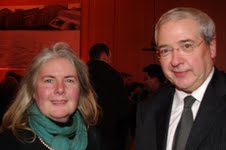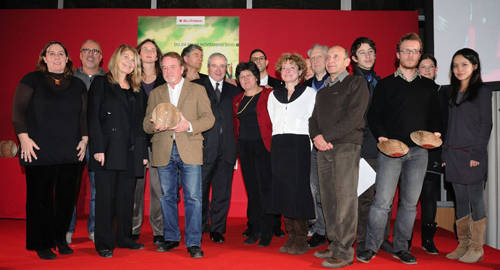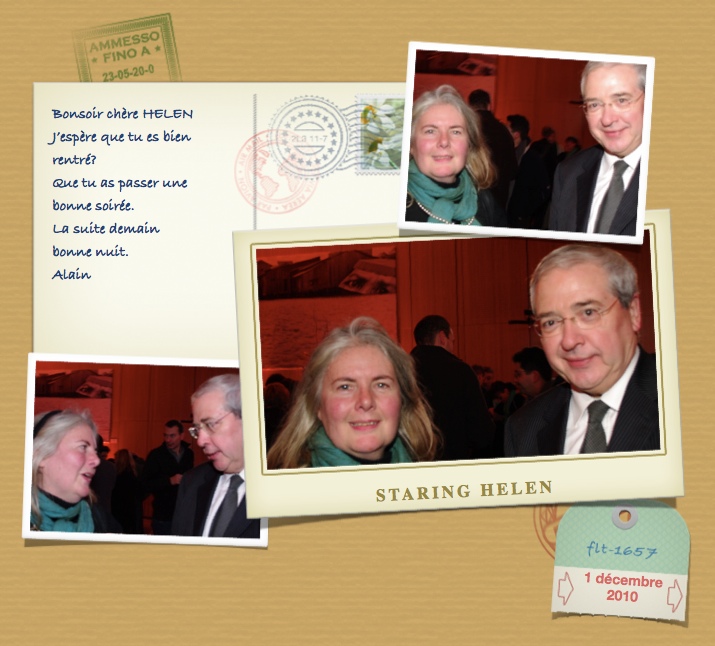THE MERRY WIDOW (Metro-Goldwyn-Mayer, US 1925)
is the opening night film at the 2009 Giornate de Cinema Muto 200,
The Music
When I first accompanied The Merry Widow years ago, I was totally struck by this highly creative and inventive film adaptation of the operetta, directed by the genius Erich von Stroheim. Immediately I realized that my “one” piano + singer accompaniment wasn’t at all enough to serve this brilliant film. I started a serious quest to develop a score for the film, and at the same time to promote this relatively unknown von Stroheim film wherever I possibly could.
In 2006 I was offered the chance to create a score for 6 musicians for The Merry Widow. I became interested in the search for the “original score” from 1925, when Franz Lehár’s operetta music was used, arranged by William Axt and David Mendoza. This score was for a large orchestra.
At that time it was very difficult to find the original score, and as my deadline was getting ever closer I decided to write my own score. This score is partly based on the captivating lyrical music of Lehár and partly on my own music. This gave me the opportunity to bring a bit more Stroheimian darkness and satire into the accompaniment. The decision of exactly where to place the Lehár motifs in the film was a very interesting and challenging puzzle to solve.
In 2007 I enlarged the ensemble to 10 musicians for bigger venues, and at the same time had the great good luck to get official permission from the Lehár Estate to use and rearrange, where necessary, the original operetta music for the film. In 2008 I made a second version for larger string orchestra. This version was premiered in February 2008 at the Komische Opera in Berlin.
I’m very honored that in 2009 the Giornate has given me the opportunity to share with you all such an incredible film. I hope the music will help you to feel the immense intensity of the images perhaps even a little bit more... – Maud Nelissen
The Merry Widow Affair [Kevin Brownlow]
The Merry Widow could not have started less auspiciously. Erich von Stroheim was all set to direct this Mae Murray vehicle when he heard that the job was to go to her husband, Robert Z. Leonard. He appealed to the head of MGM; Louis B. Mayer became incensed when Stroheim declared that the girl would be a whore – and he struck Stroheim.
Mayer had once salvaged junk, and packed a mean punch. But there was more to it than outraged decency. A few months earlier, Mayer had merged with Metro and Goldwyn, and one of the films he had inherited was Greed, a drama as far from Mayer’s ideal of a good picture as it was possible to get.
Vice-President Irving Thalberg had already done battle with Stroheim when both had worked at Universal. “The Boy Wonder” had been put in charge of the studio at the age of 20. Alarmed by Stroheim’s extravagance during production of Merry-Go-Round (1923), Thalberg decided it had to stop, once and for all, and fired the director. It was a historic moment for Hollywood, for it meant that from then on, power lay in the hands of the producer.
After this defeat, Stroheim was invited to join the Goldwyn Company. Its creative head was June Mathis, a successful scenario writer, who firmly believed in the power of the director. Stroheim was able to make Greed without interference. When he finished editing the film (the best he could do was to cut it from 42 to 22 reels), the new triumvirate ordered the masterpiece slashed to 10 reels, prompting Stroheim to snarl: “The man who cut my picture had nothing on his mind but a hat.”
Despite everything, Stroheim and Thalberg retained their respect for each other. Thalberg approved of The Merry Widow – which had first been announced when Stroheim joined Goldwyn – and agreed that the adaptation could be as free as he liked, so long as it contained two scenes the public loved: the famous waltz and the scene at Maxim’s. Using the Franz Lehár operetta as a springboard, Stroheim, working with Benjamin Glazer, fashioned an ironic comedy-drama, which also allowed him to indulge in one of his favorite themes, an examination of the degeneration of power.
In a little Balkan state, Prince Danilo and Crown Prince Mirko, cousins, both fall for a visiting American dancer, Sally O’Hara. Danilo, the more charming of the two, bewitches her. One night, he is at the point of seducing her when Mirko and his drunken comrades burst in. “Be careful, sirs,” says Danilo. “You dare to insult the future Princess Petrovich.” Mirko withdraws, defeated. The king, however, is infuriated by the news, and forces Danilo to retract. When she is abandoned on her wedding day, Sally takes her revenge by marrying the crippled Baron Sadoja, whose millions support the throne. And when the wedding night proves too much for him and he expires, she departs for Paris to splash his millions across the continent – the Merry Widow.
Stroheim agreed to use Mae Murray in the lead. He wanted Norman Kerry for Danilo, but Thalberg refused. He also vetoed any idea that Stroheim might play Mirko. Thalberg knew that he could always fire Stroheim as director, but if Stroheim played a leading role, he would have to retake everything shot to date. For some weeks they tried to cast the part, without success. There wasn’t an actor in Hollywood with Stroheim’s presence, or menace. Then Stroheim took his wife to a musical show. Valerie von Stroheim was a remarkable woman. Stroheim was in the habit of bringing her to the set and consulting her after every shot. She had no education in the art of picture-making; she reacted intuitively, and Stroheim came to depend on her judgement. Now Valerie proved her ability once again. She pointed out an actor named Roy Giusti: “There’s your crown prince.” With a change of name to Roy D’Arcy, he played a splendidly snakelike Mirko.
Richard Koszarski, in his definitive biography The Man You Loved to Hate, sees Mirko as the evil aspect of Danilo, Stroheim having split the Prince’s character in two. Both have “the unmistakable air of being born in uniform”! (p.155)
Everyone in Hollywood was convinced that Stroheim was of noble birth and that he had served as a cavalry officer. He certainly gave that impression. When he arrived in Hollywood in 1914 as a penniless actor, he called himself “Count”. Actually, Stroheim was not a “von” at all, but the son of a Jewish hatter, and his military career spanned little more than a short stretch as a private. However, like so many people of intense but frustrated aspirations, he knew more about the military than most officers.
Perhaps because of the pretense in his life, he had a passion for accuracy in his work. While other directors would ensure that everything looked reasonably correct, Stroheim ensured that everything was correct. The uniforms in his films were original; the carriage for the emperor of Austria in Merry-Go-Round was the carriage of the emperor of Austria, purchased in Vienna and sent to Universal City.
Although the operetta was set in a make-believe country named Marsovia, Stroheim based it closer to reality – while calling it Monteblanco, he used the uniforms of Montenegro. Stroheim was furious when he discovered that the sword knot of the crown prince’s aide-de-camp was not made of genuine silver cord. No one in the audience would notice, he was told, but that was not the point. Stroheim’s direction depended on the accumulation of countless tiny details, often shown in close-up. So it was essential that they be perfect. He often used the example of a surgeon picking up the wrong instrument – the scene would be false to every doctor in the audience. Everyone is an expert on something. And when an actor knew that what he was wearing was not a rough copy, run up in the wardrobe department, but was absolutely correct in every detail, it had an effect on his performance – on his very bearing.
On the surface, Stroheim might have been playing war games, but there was a profundity to his work that made all this fuss over details worthwhile. He had a psychiatrist’s understanding of sexual relations, and in his presentation of lust scenes – as opposed to love scenes – he went so much further than anyone else that he bypassed the myopic vision of the Hays Office. Of course, they insisted on him cutting his orgy scenes – he expected that – but they left in a lot that, under their rules, should have been censored.
"Von Stroheim’s penchant is Freud, with trimmings by Havelock Ellis, and sauce by Krafft-Ebing,” wrote Don Ryan, who played Mirko’s adjutant. Some of the characters in the picture, he added, would be recognized only by those of a similar bent: “The baron, for instance, has a hideous form of paralysis. He walks, horribly, like a crawling thing, holding himself erect on two ebony canes. His face is chalky, on one cheek burns a livid circle. And when he looks at a woman, he sees only her feet.” Not even Thalberg recognized the full implication of his character. In one of Hollywood’s favourite stories, he and Stroheim are watching rushes; shot follows shot of the contents of the baron’s wardrobe – nothing but shoes. Thalberg demands an explanation. “Can’t you see?” says Stroheim. “He is a foot fetishist.” “And you,” replies Thalberg, “are a footage fetishist.”
No Stroheim film was complete without an orgy. It was the orgy in Merry-Go-Round that had led Thalberg to fire him from Universal, for Stroheim had insisted on real champagne and real caviar. Besides which, he had a habit, in the interests of authenticity, of casting real prostitutes in these scenes. Of course, if even glimpses of such orgies could get by the Hays Office, they were of tremendous box-office value, so no one actually discouraged Stroheim from shooting them.
Stroheim added a startling touch to the bordello scene – a group of six musicians, their bodies painted chalk white. The girls wore pearls clustered around their bosoms; the boys had lip-rouged mouths and blond wigs. They were “The White Orchestra”. So much of the orgy was cut that they were hardly glimpsed in the final cut. But two of them were used in the private room at a maison de rendezvous, in which Danilo gives supper to Sally. Audiences were so stunned by the sight of the two musicians, blindfolded and almost naked, lying on the four-poster bed, that they hardly had eyes for the surrounding decor. Stroheim’s art director, Richard Day, decorated the room like a church. Drink was served in communion cups. It was one of Stroheim’s most provocative sets, and John Gilbert was so impressed he remodelled his own bedroom to match it.
Norman Kerry had been Stroheim’s choice for the part of Prince Danilo; both Thalberg and Mae Murray had insisted on Gilbert, whose performance in a similar role in King Vidor’s His Hour had caused astonishment. Stroheim put his cards on the table at the start of production: “Gilbert, I am forced to use you in my picture. I do not want you, but the decision was not in my hands. I ensure you I will do everything in my power to make you comfortable.” Gilbert later wrote: “If you have ever sensed humiliation, you may be able to understand my reaction to the foregoing speech. I guaranteed von Stroheim that I would do my best to please him, and hated him in my heart.” During the first week, Stroheim behaved with courtesy toward Gilbert; during the second, he behaved like a drill sergeant. In the third week Gilbert went to his dressing room and tore off his uniform; Stroheim followed, and apologized. “Whereupon,” wrote Gilbert, “we had a little drink. I apologized to Von, and we had another little drink. Then we had a drink, and I returned to the set. That disagreement cemented a relationship which for my part will never end.”
Mae Murray presented an altogether more forbidding obstacle. She had set her heart on the film being full of romantic sparkle, for she wanted it to be the high point of her career. Known as “The Girl with the Bee-stung Lips”, Murray was a Star with a capital S. Describing herself as “the queen of MGM”, she lived in a fairyland as far from the brutal realism of Stroheim as Elinor Glyn from Zola. In her autobiography she declares that she and she alone was responsible for rescuing The Merry Widow from a saga of loathsome degeneracy and restoring it to a beautiful romance, that she sent telegrams every evening to MGM’s East Coast offices warning them of what was going on. She goes so far as to say that Stroheim refused to shoot any close-ups of her, and that she and her cameraman (Oliver Marsh) crept back to the stage every evening and shot them secretly. Her account is so patently absurd to anyone who has worked in pictures that most of it can be discounted. However, there were two camera crews attached to the picture – Oliver Marsh and Ben Reynolds with William Daniels.
Murray insists Stroheim refused to shoot the famous waltz scene, even though Thalberg and he had agreed on it as a high point, and even though an elaborate set had been built. Stroheim intended to cover the scene with five cameras to avoid stopping and starting the dance; the orchestra (conducted by Xavier Cugat) and the dancers would be kept in precise tempo by the music of the Lehár waltz played on a phonograph. Murray demanded that the extras stop dancing as soon as she appeared and form a pathway to enable her to make a grand entrance. “Wait a minute,” said Stroheim. “This is not a Mae Murray production. You don’t have to have a pathway to the star. Act like human beings.” Murray became so heated that Mrs. von Stroheim suggested they shoot it her way once. Stroheim agreed, in bad humour. “Tell me when the damn thing is done,” he snapped to Oliver Marsh. Murray, now seeing only the brutal World War I screen villain obstructing her artistic vision, turned on Stroheim. “Why, you dirty Hun!” she screamed.
Since Murray’s real name was Koenig, and her father was from the same country as Stroheim, this was a curious choice of epithet. However, it was enough to bring production to an embarrassed halt. The extras began hissing Mae Murray, who threw her fan to the floor and was escorted, weeping, to her dressing room. “What do we do now?” Stroheim asked his wife. “We go home,” she said. Stroheim felt that first he had to register a complaint. Thalberg was ill, and he knew Mayer would be no help, so he marched into the office of Harry Rapf. “l’m through,” he said. “Sold!” said Rapf, with delight. He knew that if Stroheim quit, he would lose his share of the profits.
After lunch, Monta Bell was asked to take over. Bell had been an assistant with Chaplin, and was an excellent director, though hardly in the same exalted league as Stroheim. Mayer came on the set with Bell and Eddie Mannix, a former bouncer who now ran the studio. A stagehand moved forward menacingly, and Mannix knocked him down. Mayer mounted the camera rostrum and introduced Bell as the new director. Then Bell began to direct the ballroom scene as Mae Murray wanted it, but it was hopeless. Mayer began to shake his head, and turned to climb down from the rostrum, when it seemed that a great cheer broke out. But it was not a cheer; it was a long drawn-out cry of “V-o-n! Von Stroheim! We want von Stroheim!” Not all the extras shouted – those who did were led by a group of men known as the Elite Guard, former officers of European armies, who were so loyal to Stroheim that none of them realized their action was tantamount to mutiny.
That evening, crisis talks were held. Two members of the Elite Guard acted as couriers between Mayer and Stroheim. At midnight they brought the protagonists together, and a settlement was worked out. The incident made headlines in the Los Angeles Record: MAE-VON SIGN PEACE. STROHEIM WINS IN SETTLEMENT. And who were the two men who brought about such a victory? Wartime enemies – Baron Wilhelm von Brincken, former captain in the Life Hussars of the King of Saxony (and a German spy), and Owen Martin, a former British army major.
Stroheim returned in triumph. He and Mae Murray coldly apologized to each other (in her version, he dropped to one knee and kissed her hand). To celebrate the completion of the picture, Stroheim was given a banquet, which even Mae Murray attended, and was presented with a gold-and-diamond cigarette case with everyone’s name inscribed on it. Mayer did not blacklist the extras, which was just as well, for one of them was Clark Gable.
The euphoria was not long-lasting. Thalberg, recalling the editing nightmare of Greed, refused to allow Stroheim the privilege of cutting the film. Stroheim was so upset that he asked to be released from his contract. MGM let him go. He refused to attend the previews or the premiere. Instead, he paid to see the film at a regular showing. “They applauded,” said Stroheim. “They laughed and thought it was great. But l’m shrinking in my seat because l’m ashamed.” He objected particularly to the happy ending, with a coronation in two-colour Technicolor; he said that his version ended with Danilo falling in a duel, with Mirko and Sally rushing to his side. Yet Stroheim had directed the happy ending himself, and it was in his script!
The picture was a smash hit, and was greeted by ecstatic reviews. “Mae Murray said von Stroheim was ruining the picture,” said Photoplay. “She should pray for another director equally inconsiderate.” Murray had predicted that the great Franz Lehár would disown the picture, yet he conducted the orchestra at its Vienna premiere. The film was banned in Yugoslavia, Germany, and Fascist Italy. It allegedly made a profit of $758,000 for the studio. Stroheim should have received 25 percent of this, but Mayer used his share to pay off the losses of Greed. Stroheim’s contract called for profit and loss to be pooled, so he had no grounds for a lawsuit.
Someone else did. Stroheim’s passion for authenticity outraged Prince Danilo of Montenegro, whose principality had been absorbed into Yugoslavia after the Great War. He was apoplectic at the way his namesake was portrayed on the screen. He demanded 100,000 francs from MGM for invasion of privacy – and won. Without realizing it, Stroheim had his revenge on Louis B. Mayer. (Adapted from Kevin Brownlow's article “The Merry Widow Affair”, American Film, July-August 1981; ; with thanks to Richard Koszarski)
Subscribe
Subscribe to this page
To Blog entry content
To Blog entry content by Helen
To content in Promo showcase
To content in Promo showcase by Helen


























 Helen Dobrensky
Helen Dobrensky 



Post new comment